I am making a object detection project.
I have my code. And I have written it by following a tutorial. In the tutorial, the guy drew a rectangle in opencv for every single object which is detected.
But I want to change the rectangle to triangle or Arrow.
let me explain with code===>
In my function, I detect objects. And here I draw rectangle for detected objects==>
cv2.rectangle(img, (x, y), (x+w,y+h), (255, 0 , 255), 2)
But I want to change this rectangle to a triangle.(And I want to set position of triangle to above of object. Just like in these images:::
This is the object detection with triangle [![enter image description here][1]][1]
This is the thing that what I want to make instead of rectangle::: [![enter image description here][2]][2]
How Can I make a triangle/arrow with positions of my detected objects? All of my code is here==>
from os.path import sep
import cv2 as cv2
import numpy as np
import json
# Camera feed
cap_cam = cv2.VideoCapture(0)
ret, frame_cam = cap_cam.read()
hey = 0
print(cv2. __version__)
whT = 320
confThreshold =0.5
nmsThreshold= 0.2
classesFile = "coco.names"
classNames = []
with open(classesFile, 'rt') as f:
classNames = f.read().rstrip('\n').split('\n')
print(classNames)
## Model Files
modelConfiguration = "custom-yolov4-tiny-detector.cfg"
modelWeights = "custom-yolov4-tiny-detector_last.weights"
net = cv2.dnn.readNetFromDarknet(modelConfiguration, modelWeights)
net.setPreferableBackend(cv2.dnn.DNN_BACKEND_OPENCV)
net.setPreferableTarget(cv2.dnn.DNN_TARGET_CPU)
def findObjects(outputs,img):
global hey
global previousHey
hT, wT, cT = img.shape
bbox = []
classIds = []
confs = []
for output in outputs:
for det in output:
scores = det[5:]
classId = np.argmax(scores)
confidence = scores[classId]
if confidence > confThreshold:
w,h = int(det[2]*wT) , int(det[3]*hT)
x,y = int((det[0]*wT)-w/2) , int((det[1]*hT)-h/2)
bbox.append([x,y,w,h])
classIds.append(classId)
confs.append(float(confidence))
global indicates
indices = cv2.dnn.NMSBoxes(bbox, confs, confThreshold, nmsThreshold)
hey = 0
for i in indices:
i = i[0]
box = bbox[i]
x, y, w, h = box[0], box[1], box[2], box[3]
# print(x,y,w,h)
cv2.rectangle(img, (x, y), (x+w,y+h), (255, 0 , 255), 2)
#cv2.line(img, (350,400), (x, y), (255,0,0), 4)
#cv2.line(img, (400,400), (x + 50 , y), (255,0,0), 4)
#cv.putText(img,f'{classNames[classIds[i]].upper()} {int(confs[i]*100)}%',
#(x, y-10), cv.FONT_HERSHEY_SIMPLEX, 0.6, (255, 0, 255), 2)
print('success')
hey = 1
video_frame_counter = 0
while cap_cam.isOpened():
img = cv2.imread('photos' + sep + 'lutfen.jpg')
#BURADA OK VİDEOSU OYNATILACAK
#if not decetiona diye dene yarın.
blob = cv2.dnn.blobFromImage(img, 1 / 255, (whT, whT), [0, 0, 0], 1, crop=False)
net.setInput(blob)
layersNames = net.getLayerNames()
outputNames = [(layersNames[i[0] - 1]) for i in net.getUnconnectedOutLayers()]
outputs = net.forward(outputNames)
findObjects(outputs,img)
cv2.imshow('Image', img)
# Video feed
if hey == 1:
filename = 'photos' + sep + 'Baslksz-3.mp4'
cap_vid = cv2.VideoCapture(filename)
if hey == 0:
filename = 'photos' + sep + 'vid2.mp4'
cap_vid = cv2.VideoCapture(filename)
print(hey)
ret, frame_vid = cap_vid.read()
#cap_cam.set(cv2.CAP_PROP_FRAME_WIDTH, 1920)
#cap_cam.set(cv2.CAP_PROP_FRAME_HEIGHT, 1080)
# Resize the camera frame to the size of the video
height = int(cap_vid.get(cv2.CAP_PROP_FRAME_HEIGHT))
width = int(cap_vid.get(cv2.CAP_PROP_FRAME_WIDTH))
# Capture the next frame from camera
ret, frame_cam = cap_cam.read()
video_frame_counter += 1
if video_frame_counter == cap_vid.get(cv2.CAP_PROP_FRAME_COUNT):
video_frame_counter = 0
cap_vid.set(cv2.CAP_PROP_POS_FRAMES, 0)
frame_cam = cv2.resize(frame_cam, (width, height), interpolation = cv2.INTER_AREA)
#ret = cap_vid.set(cv2.CAP_PROP_POS_MSEC, time_passed)
ret, frame_vid = cap_vid.read()
if not ret:
print('Cannot read from video stream')
break
# Blend the two images and show the result
tr = 0.4 # transparency between 0-1, show camera if 0
frame = ((1-tr) * frame_cam.astype(np.float) + tr * frame_vid.astype(np.float)).astype(np.uint8)
cv2.imshow('Transparent result', frame)
if cv2.waitKey(1) == 27: # ESC is pressed
break
cap_cam.release()
cap_vid.release()
cv2.destroyAllWindows()

